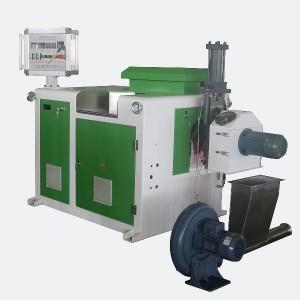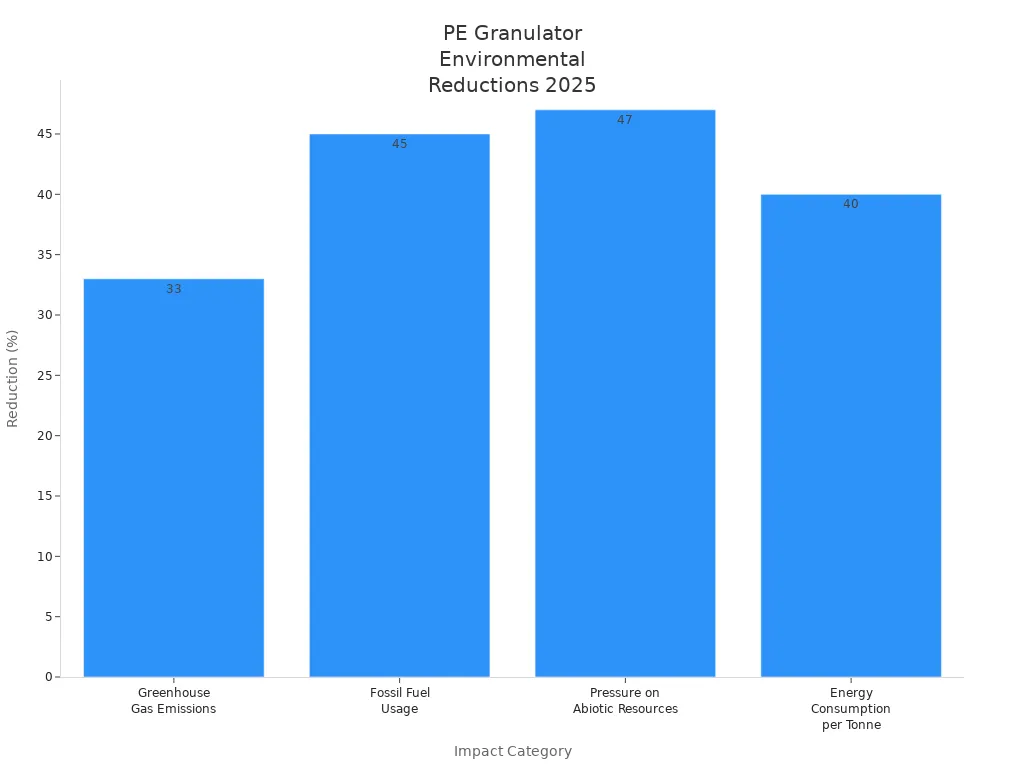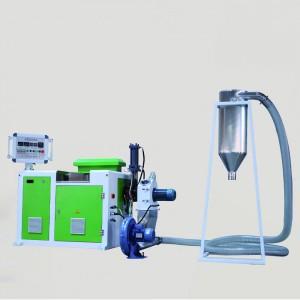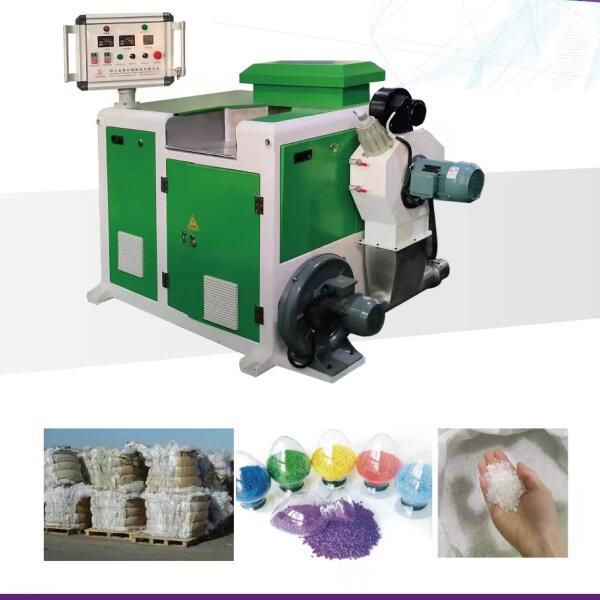
PE small environmentally granulators in 2025 use high-efficiency motors, process optimization, and real-time automation to cut energy use. Operators see immediate results, such as a 40% drop in energy consumption per tonne compared to traditional single screw machine or vented single screw extruder systems. Waste heat recovery also supports waterless granulator machine operations.
| Metric | Reduction Achieved in 2025 Compared to Previous Years |
|---|---|
| Greenhouse Gas Emissions Reduction | 33% decrease |
| Fossil Fuel Usage Reduction | 45% decrease |
| Pressure on Abiotic Resources | 47% decrease |
| Energy Consumption per Tonne | As low as 10 kW-h/tonne, 40% less than traditional equipment |

PE Small Environmentally Granulators: Energy-Saving Technologies

High-Efficiency Motors and Transmission Devices
PE small environmentally granulators in 2025 rely on high-efficiency motors and advanced transmission devices to achieve significant energy savings. These motors convert electrical energy into mechanical power with minimal loss, ensuring that most of the input energy drives the granulation process. Advanced transmission devices further enhance this efficiency by optimizing how energy moves from the motor to the cutting and extrusion components. When combined, these technologies reduce overall energy consumption during operation. This integration forms a comprehensive energy-saving strategy that supports both low energy use and high production efficiency. Manufacturers benefit from lower electricity bills and improved equipment performance. The use of high-efficiency motors and transmission devices also extends the lifespan of the granulator, reducing maintenance needs and downtime.
Tip: Upgrading to high-efficiency motors and transmission systems can cut energy use by up to 30% compared to older models.
Intelligent Automation and Process Optimization
Intelligent automation stands at the core of modern PE small environmentally granulators. These systems use smart controls to monitor and adjust key performance indicators such as temperature, motor speed, and vibration. Operators can rely on features like PLC touch screens, which allow dynamic adjustments to temperature and pellet size. Sensors detect issues like die clogging or motor overload, reducing the risk of unexpected downtime.
- Smart granulator controls track performance indicators for predictive maintenance.
- AI-based systems inform maintenance planning, such as when to change knives or grease bearings.
- Cloud-based platforms enable remote monitoring and send maintenance reminders.
- Power cabinet wiring supports easy integration with other equipment.
- Automation reduces manual intervention, improving safety and reliability.
- Process optimization fine-tunes operating parameters, streamlining granulation and reducing energy waste.
- Modular design allows customization for different materials and production needs.
Process optimization techniques further boost energy efficiency. Integrated machine designs combine shredding, cutting, extrusion, and pelletizing into one continuous operation. This approach reduces labor, time, and energy use. Consistent feeding mechanisms stabilize material flow, preventing downtime and improving output quality. Automation features like auto feeding control, dual channel filters, and auto-adjustment of knife speed ensure smooth and efficient production. Energy-efficient motors, variable speed drives, and advanced cooling systems also contribute to lower energy consumption.
Waste Heat Recovery and Utilization
Waste heat recovery represents a major advancement in PE small environmentally granulators. During the granulation process, machines generate heat as a byproduct. Instead of letting this heat escape, modern systems capture and reuse it. Technologies such as high-temperature heat pumps and latent heat storage systems using phase change materials (PCMs) recover low-temperature waste heat and upgrade it for use in process steam generation or space heating. In demonstration factories, hybrid heat pump systems have recovered over 80% of waste heat, reducing reliance on electric heating to less than 20%. This not only improves overall energy efficiency but also delivers a strong economic return, often paying for itself in under three years. The combination of heat storage and heat pumps enables continuous operation and load shifting, further cutting energy costs and lowering CO2 emissions.
| Technology | Function | Impact on Energy Use |
|---|---|---|
| High-Temperature Heat Pump | Upgrades waste heat for process steam | Reduces electric heating |
| Latent Heat Storage (PCM) | Stores and releases heat as needed | Enables load shifting |
| Hybrid System | Combines both for maximum efficiency | Recovers 81.1% of waste heat |
PE small environmentally granulators set a new standard for energy efficiency in plastic recycling. Their advanced energy-saving technologies help manufacturers lower costs, improve productivity, and support environmental goals.
Benefits of PE Small Environmentally Granulators in 2025

Reduced Operational Costs and Energy Use
Manufacturers see clear cost savings when they use PE small environmentally granulators. Air-cooled models remove the need for water, which saves money on water treatment and equipment upkeep. These granulators use less energy than water-cooled systems because of their simple design and improved efficiency. Maintenance becomes easier, and the risk of breakdowns from water system problems drops. Operators can run these machines in places with little water or poor air quality, keeping production steady. Uniform cooling also improves product quality and reduces waste.
- Air-cooled operation eliminates water costs and related maintenance.
- Lower energy use means smaller electricity bills.
- Simple structure reduces repair needs and downtime.
- Stable performance in tough environments ensures reliable output.
- Better product quality leads to less waste and higher efficiency.
Environmental Impact and Carbon Footprint Reduction
PE small environmentally granulators help companies lower their environmental impact. They cut carbon emissions and energy use, making plastic processing greener.
| Environmental Benefit | Detail |
|---|---|
| CO2 Emission Reduction | 1.5 tonnes CO2 reduced per tonne of regenerated pellets |
| Energy Consumption Reduction | 30% less energy used by new low-speed granulators |
| Noise Reduction | 20dB lower noise levels |
| Recycling Rate Improvement | Closed-loop recycling reduces raw material use |
| Case Example – Automotive | 300 tonnes of new plastic saved yearly by recycling bumper waste |
| Case Example – Agricultural | 85% conversion rate achieved by Indian farmers using small-scale pelletisers |
These machines also support the circular economy by turning plastic waste into reusable granules. This process reduces landfill waste and saves natural resources.
Compliance and Adaptability for Industry Standards
PE small environmentally granulators help companies meet strict environmental rules in many regions. The machines support recycling and reduce landfill use, which aligns with government programs for zero waste. Many models meet international standards like ISCC PLUS, which tracks sustainable feedstock use and ensures compliance with social and environmental goals. Their flexible design fits both large and small operations, helping businesses adapt to changing regulations. Advanced automation and energy-saving features make it easier to follow new rules on emissions and noise. Companies in North America and Europe use these granulators to support circular economy goals and meet local and global standards.
PE small environmentally granulators achieve high energy efficiency by using low-speed designs, customizable features, and advanced recycling technology. These machines help industries lower costs, reduce waste, and support the circular economy. Companies choosing these granulators improve sustainability, meet regulations, and create a cleaner future.
FAQ
How does the PE small environmentally granulator save energy?
The granulator uses high-efficiency motors and advanced automation. These features lower electricity use and reduce waste during plastic granule production.
Tip: Regular maintenance helps keep energy savings high.
Can the granulator handle different types of plastic waste?
Yes. The machine supports various plastic materials. Operators can adjust settings for each type, ensuring consistent granulation and quality output.
What maintenance does the granulator require?
Operators should check motors, clean filters, and inspect cutting blades regularly. Simple controls and modular parts make routine maintenance fast and easy.
Post time: Jul-17-2025
